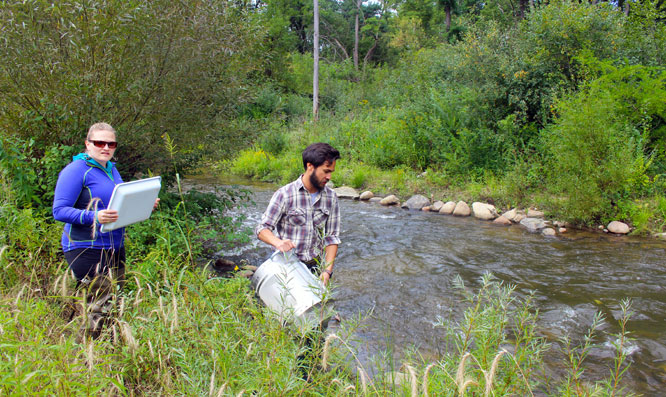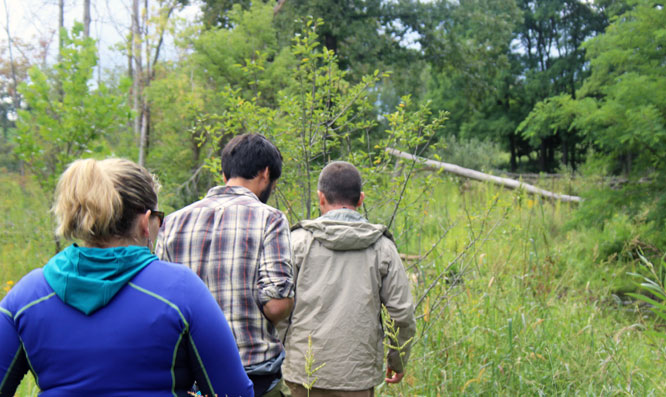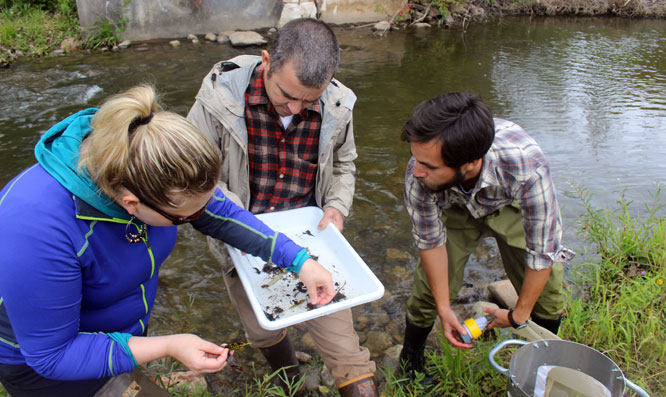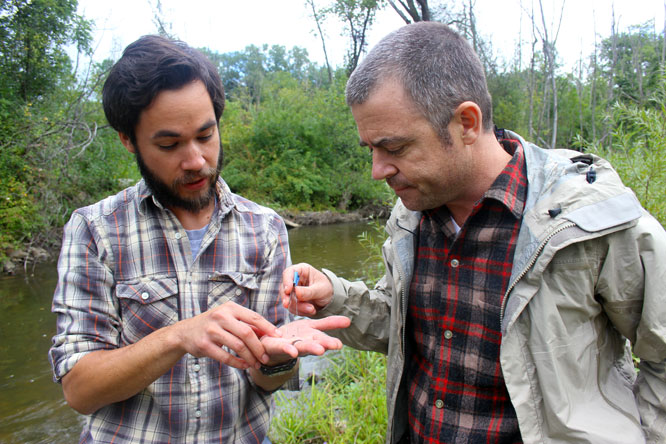By Katie Land, news editor
 |
| Grad students Anita Baxter and Jeremy Geist collect samples at Paint Creek. |
Not far from Oakland University’s Rochester campus lies what used to be the Paint Creek Dam. Removed about two years ago, the river now flows freely and is home to dozens of species of insects, plant life, and opportunities for biological study.
“The Paint Creek became a river again for the first time in 150 years,” said Scott Tiegs, Ph.D. and assistant professor of biology. “We had the opportunity to study the effects of the dam before and after its removal. It has been good for the community, the university and our students to be a part of the ecological restoration work, and study how to make dam removals more effective.”
Spearheaded by the Clinton River Watershed Council, the removal of the dam was funded by a $750,000 Environmental Protection Agency grant, roughly $48,000 of which went to support Oakland research that includes the work of two graduate students.
Master of Science in Biology students Anita Baxter and Jeremy Geist have been on site throughout the entire process, beginning several years ago. Both have made comprehensive studies of various aspects of the creek’s life for their thesis projects, and both intend to graduate this December.
Baxter is focused on organic matter dynamics and its response to the creek’s ecological restoration. She documents leaf decomposition rates and measures streamwater nutrients, along with other aspects of water chemistry.
“Removing the main structure of the dam has been very interesting,” Baxter said. “It changed the water depth, increased the water flow and increased the variety of insects found in the leaf litter. From two years ago to now, the physical changes to the area are huge. It looks like a completely different place.”
Geist’s specialty is aquatic invertebrate response, or the bug reaction to the dam’s removal. Able to identify dozens of species of insects in an instant, Geist has watched the Paint Creek’s insect community thrive. Throughout the project, Geist has balanced his time between work in the field and in the lab.
“The invertebrate community provides a good indication of overall stream health. The diversity, quantity and type of insects can indicate pollution or temperature changes,” he said. “Having the opportunity to work with the Watershed has offered good practical experiences and OU’s Aquatic Ecology Lab has helped us build professional skills as well.”
The Paint Creek flows southeast from Brandon Township through Oakland Township to Rochester, where it meets the Clinton River. The Paint Creek Dam used to sit upstream from Orion Road. The Clinton River Watershed Council and the Michigan Department of Natural Resources and Environment (MDNRE) supported the removal of the dam citing safety and to protect the creek’s fish and wildlife habitats.
“Overall the community has been super supportive,” Dr. Tiegs said.
 |
|
“They have been helpful and welcoming to our students, and we have had the opportunity to conduct grad and undergrad research out here. Additionally, Paint Creek is a great place for trout fishing, and the restoration project should really improve the fishing. The trout fishermen have all been in favor of the dam removal.”
The removal of the Paint Creek Dam follows a national trend of removing outdated, dangerous, and ecologically damaging dams from river systems. Hundreds of dams have been removed across the country in the last several years and many more are scheduled for removal.
For more information about programs, courses and research in Oakland’s biology department, view the website at
oakland.edu/biology. Learn more about OU’s Aquatic Ecology Lab
at the website.
To learn more about academics, achievements, and events at OU, visit the news site at
oakland.edu/newsatou and follow the news team on Twitter at
@OaklandU_News.




